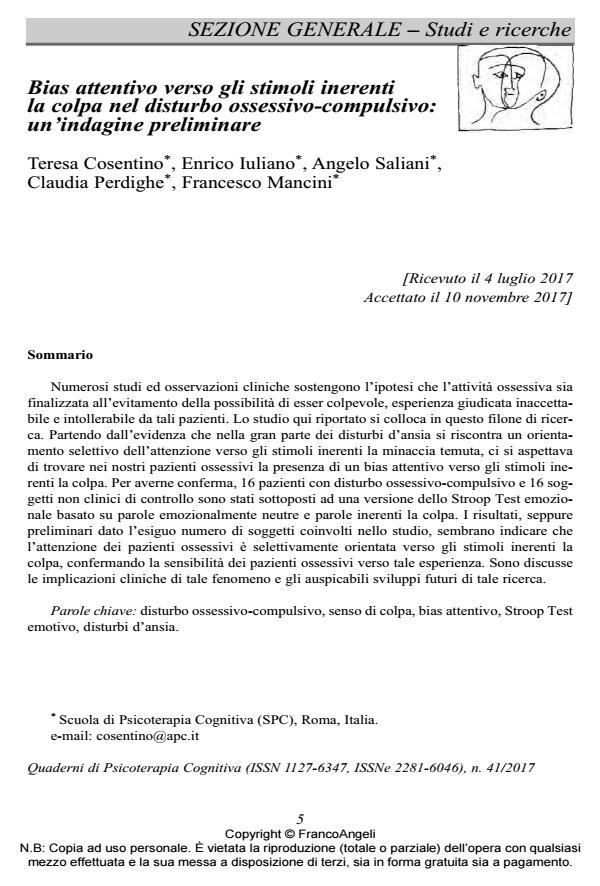Attentional bias towards stimuli concerning guilt in obsessive-compulsive disorder: a preliminary study
Journal title QUADERNI DI PSICOTERAPIA COGNITIVA
Author/s Teresa Cosentino, Enrico Iuliano, Angelo Saliani, Claudia Perdighe, Francesco Mancini
Publishing Year 2017 Issue 2017/41
Language Italian Pages 13 P. 5-17 File size 163 KB
DOI 10.3280/QPC2017-041001
DOI is like a bar code for intellectual property: to have more infomation
click here
Below, you can see the article first page
If you want to buy this article in PDF format, you can do it, following the instructions to buy download credits

FrancoAngeli is member of Publishers International Linking Association, Inc (PILA), a not-for-profit association which run the CrossRef service enabling links to and from online scholarly content.
Several studies and clinical observations support the hypothesis that the obsessive activity is intended to prevent the possibility of being guilty, experience judged intolerable and unacceptable from such patients. This study fits into this line of research. Starting from the evidence that in most anxiety disorders there was a selective attention directed towards the stimuli inherent threat feared, we expected to find in obsessive patients the presence of an attentional bias towards stimuli inherent to guilt. To assess the presence of attentional bias, sixteen subjects with obsessive-compulsive disorder and sixteen non-clinical control subjects underwent a Stroop Emotional Test based on stimulus words concerning guilt and neutral stimulus words. The results show that only the obsessive-compulsive subjects had greater slowness in naming the color of the words concerning guilt compared to the neutral ones. These results, although preliminary as derived from a small sample of subjects, seem to indicate that the patient’s obsessive attention is selectively directed towards the stimuli inherent guilt, confirming the patient’s sensitivity to this experience. The clinical implications of this phenomenon and the desirable future developments of this study are discussed.
Keywords: Obsessive-compulsive disorder, guilt, attentional bias, Stroop Emotional Test, anxiety disorders.
Teresa Cosentino, Enrico Iuliano, Angelo Saliani, Claudia Perdighe, Francesco Mancini, Bias attentivo verso gli stimoli inerenti la colpa nel disturbo ossessivo-compulsivo: un’indagine preliminare in "QUADERNI DI PSICOTERAPIA COGNITIVA" 41/2017, pp 5-17, DOI: 10.3280/QPC2017-041001